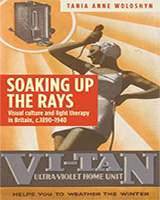Soaking up the rays forges a new path for exploring Britain’s fickle love of the
light by investigating the beginnings of light therapy in the country, from c.1890–1940.
Despite rapidly becoming a leading treatment for tuberculosis, rickets and other
infections and skin diseases, light therapy was a contentious medical practice. Bodily
exposure to light, whether for therapeutic or aesthetic ends, persists as a contested
subject to this day: recommended to counter psoriasis and other skin conditions as well
as Seasonal Affective Disorder (SAD) and depression; closely linked to notions of
beauty, happiness and well-being, fuelling tourism to sunny locales abroad and the
tanning industry at home; and yet with repeated health warnings that it is a dangerous
carcinogen. By analysing archival photographs, illustrated medical texts,
advertisements, lamps, and goggles and their visual representation of how light acted
upon the body, Woloshyn assesses their complicated contribution to the founding of light
therapy. Soaking up the rays will appeal to those intrigued by medicine’s visual
culture, especially academics and students of the histories of art and visual culture,
material cultures, medicine, science and technology, and popular culture.
The publisher has no responsibility for the persistence or accuracy of URLs for any external or third- party internet websites referred to in this book, and does not guarantee that any content on such websites is, or will remain, accurate or appropriate.

